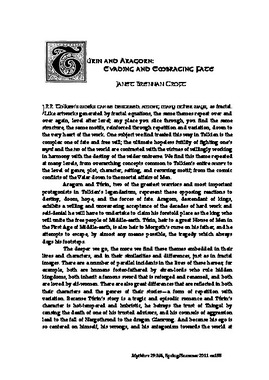| dc.description.abstract | Aragorn and Túrin, two of the greatest warriors and most important
protagonists in Tolkien’s legendarium, represent opposing reactions to
destiny, doom, hope, and the forces of fate. Aragorn, descendant of kings,
exhibits a willing and unwavering acceptance of the decades of hard work and
self‐denial he will have to undertake to claim his foretold place as the king who
will unite the free people of Middle‐earth. Túrin, heir to a great House of Men in
the First Age of Middle‐earth, is also heir to Morgoth’s curse on his father, and he
attempts to escape, by almost any means possible, the tragedy which always
dogs his footsteps. Both characters are also
notable for accumulating a great number of different names in the course of their
careers. In keeping with the fractal nature of Tolkien’s art, this is not merely a
shallow coincidence—names are important signifiers of character, plot, social
position, and relative power—and additionally, as we peel back the fractal
layers, we will see that their relationships to their multiple names also tell the
stories of their relationships to fate. | en_US |
